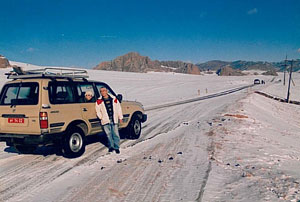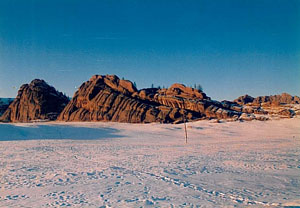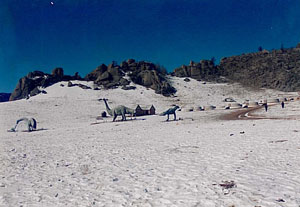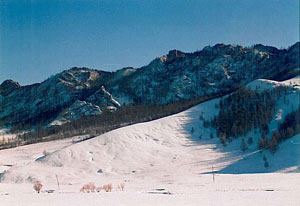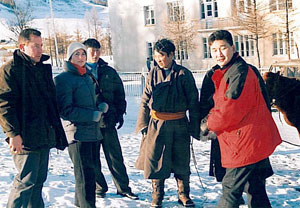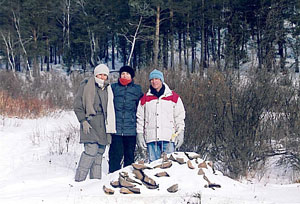Mongolian Weekly News no. 3
Date: December 5, 1999
Dear friends,
Here is yet another episode of the by-now-getting-established News from Mongolia. Even though it is 2 am here, I am very intent on finishing this on time (i.e. one week from the previous one) and being disciplined about it. Not to worry, because life in UB is rolling along at a settled pace now, indoor time much more than outdoor, for reasons of laziness and the repulsion from the cold… Some outings to outside of the city are quite necessary for healthy lungs, because when one opens the window to air out the house, what mostly blows in is air full of the smell of coal used for the city’s winter heating. It is unfortunate also that the heat generator is a huge factory/ power station adjacent to the city borders, or it may even be within the city. The streets are lined with the typical giant geometric blocks of Socialism, but the colours are refreshing blues and yellows and pastel whites mostly, which reminds me of Russian and Nordic buildings. And there are interestingly abundant classical elements, all the way down to the ankle-level reliefs lining outer walls (dadoes or reredoes?) and the false balconies with those typical curving balustrades… It goes some way to lighten up the mood on the streets, as do the UB residents playing slipping games on the icy pavements. They really look like they’re having fun with it!
UB also has many ‘art shops’ springing here and there, signs written in Latin letters (not Cyrillic or the older, vertical Sanskrit-like Mongolian script) obviously for foreigners, selling handicrafts and the like. My mother and I have dropped by a couple of these places, and the traditional dels, or full-body-length outer garments, have been the most eye-catching merchandise, beside some felt-lined boots. The dels can either be summer or winter types, one of cotton and the other of serious insulation material, i.e. felt and wool. They are also split into ones for the male and the female, both having the approximate shape of a bathrobe with a nice cloth sash to tie around the waist, but differentiated by the diagonal overlayer rim (I hope you can picture that!) kind of like a Chinese woman’s dress, the male one coming over to the right and the female one to the left. If I am correct, this kind of left-right rule also applies to shirts in Western clothing. It’s interesting how and why such a distinction is made. The anthropology of clothes..!
About the indoor hideout of the Yildirim family (3/4 of it), the residence is a peculiar place, because it is at once yours and no one’s. Every other day, all three of us (Mr., Mrs. and Miss Y.) stare at some painting or other hanging around the dining room or guest reception rooms and try to understand why it somehow doesn’t go there, and we set to work either trying to interchange its place with another that the previous ambassador or whoever decorated the house put somewhere. Or we call the house’s handyman, Toolgha (very similar to the Turkish name Tolga, for those who’ll note) to help us out with his portable-foldable-wonderful ladder. It’s our biggest ritual for making the house a personalized home, with due respect to the original decorators, of course! I have also started to get away with a little rule-breaking, which is that according to protocol, Mr. Ambassador sits at the head of the table, his wife at his left (again that left connection) and his offspring (I guess me?) at his right, and whenever there is no one but us left in the house on the weekends, I sit at the Mrs.’s place to change my scenery. What matters to deal with in your daily life! And then there is also the way the Ambassador sits at the back right seat of a car, and the lady sits at the left, for the driver to be able to dash out and open her door, and for the Ambassador to exit the car first, from the right. What details! I get all confused when one of us doesn’t come on a trip, then I just follow the driver’s and the bodyguard’s glances to guess the correct answer in this weird diplomatic game…
Speaking of the dining room, we had the first really official dinner this Friday since I came here, with no spouses of delegates (ooh! Serious negotiations, I presume!!) where my mother and I stole upstairs with our dinners and had a private first-hand taste of the yummies (which are not really yummies with this country’s limited cuisine- meat, meat and more meat- as the Lonely Planet guidebook says, Mongolia is hell for vegetarians).
As a side issue, we had a visit to the Vision Eye Clinic, what we understood to be a Christian missionary’s volunteer-based centre, because my left eye started to ache badly on Tuesday. It turned out that the cornea torn 5% in depth by our lovely and wicked cat Duman back in Ankara in 1998 did not heal properly then, and probably due to the dry weather here, the infection recurred. Now there is a four-times-a-day treatment of a gelly-like cream put into my eye, which is difficult both for the object (me) and the subject doing it (my poor mother has to deal with my fluttering eyelids). So perhaps it has been a good idea not to take Duman with us here… Further to this, we especially preferred to leave them (D. and her daughter) home, because the Mongolians do not like cats. What a pity, and surprising when it was a God in Egypt… It is funny how good and bad luck omens change from culture to culture. Another example is the way 7 is an unlucky number in Buddhism.
Speaking, this time, of good luck, I should mention the ovoos here, which are parts of the natural landscape, manmade pyramid-like piles of rocks where blue ribbons, symbols of respect, are tied to the top, and offerings are made to the ‘natural deities’ in the shape of food, money, or even a bottle of vodka!.. Well, it provides a real test in their beliefs, or superstitions as you may prefer, when a full bottle of vodka is just left out in the wilderness to tempt you! Tales of bad luck befalling those who disrespect the ovoos seem to be commonplace. This worship of natural objects is said to predate any of the region’s main religions, and connected to the people’s subconscious sense of nature’s powerful place in their existence. A few words on the old religion of Shamanism here- they are very few left now, but definitely part of the Mongolian steppes’ heritage. Shamans used to be women always, until men also started to take up the practice, dressing up in masks with long strands of cloth or hair to create women’s images. Shamanism also has a lot of natural elements in it. I think it’s fascinating, though I don’t know much on this. Several books have been written by specialists on the subject. Unfortunately I can’t remember their names right now to help out interested people.
I’d like to put in the answer to Eleni E.’s question here about the state of tourism: The tourism here is still in the process of developing, but it’s already aware of the interest, and like you already said, things are changing quickly. I think it’s the tourists who are more hesitant to come out here, and the physical obstacles like the distance and the climate, that keeps the tourism industry from going through a big boom.
This week was also highlighted by a visit to the National Museum of Mongolian History. The building is a granite-like brown block, with beautiful reliefs of horsemen on the front façade, a modernist sculpture on the right side of its forecourt and a ger at the left side. It is quite a good museum, and although the attendants do not speak English at all (we got along just fine with the funny lady at the ticket office but it took some time), the guidebooks and explanatory labels are alright. Among the most notable artefacts, were some of those ankle bones to play with that I was telling you about before, found as grave goods, and also displayed in geometrical arrangements and coloured different tones of PINK; some fantastic ethnic minority costumes with most of the female attires crowned by the great hairdo that you may recognize from Björk’s last album cover, the giant hair croissants (!), and also including a very fashionably red raincoat; a corner of a room all devoted to life-size models of Chinggis Khan and his wife, sitting regally on thrones surrounded by leopard hides and snarling stuffed heads and you-can-imagine-the-rest; and the correspondence letters between Chinggis and his successors and various European heads of state around the early Middle Ages (Claire? Is the right time period, 13th-14th cc.??), many of them on alliances for attacking the Egyptians (Egypt there again, coincidentally).
On Saturday, we went to the large Black Market, which has been exactly what it’s called, even since before the collapse of Socialism. There, some great antiques could be found, among other strange stuff like plastic waste bins, mattresses, space mechanical parts, and stationery… We bought a horse seal, which consisted of a long metal shaft with a sign at one end to be pushed glowing hot into the poor animal’s buttock. We made it into a candlestick when we turned it upside down, and now it’s standing over its sign, with the hollow handle end facing upwards to accommodate a candle. The signs varied from moons to suns to crosses and wheat grains, but we got one with a swastika. (Every time I see the swastika, I concentrate on its ancient symbolism to do with long life, fertility, etc., and not on the Nazi symbol, which shouldn’t be the one to remember. After all, they borrowed it from the ancient ones and gave it a bad name. I had thought that it made a difference which side the ends of the swastika lines were turned, but I’ve seen it used both ways, so there might not be any distinction. Oh well.) The most striking thing about the Black Market was the ruthless pushing around that everybody does to everybody. I can’t help think that polite Englishmen who even manage not to touch you in peak hour Tube wagons would probably have a heart attack here… We felt like one of those cars in fairgrounds that bump into each other in their special platforms. After a while, we even started to get the hang of it and enjoy it, but it was a challenge not to lose each other in the crowds of the market. Maybe it was better to have so many bodies around you just to keep warm in the open air!..
Lastly, today’s outing to a national park area called Terelj is worth mentioning. The wildly beautiful landscape, showing why Mongolia is called the Land of Blue Skies, the wild cattle of all colours along the way, and the interesting wooden bridges where vehicles passed that had dangerous-looking holes in their centres were some features of the ride there. The way into the site also had some life-size statues of dinosaurs, the ones I was saying lived in the Gobi Desert and had their own museum in UB. (Correction from last time: the Gobi was also home to some ancient peoples, not just dinoes. Nondas is asking about any possible connection with Jurassic Park, but I can assure you this could only be an early proto-type of those studio settings, however graceful they have done it.) Once there, my mother took up skiing with our ancient cross-country skis for about an hour by a frozen river and my father immersed himself in his usual newspapers in the café of a hotel on site, while the bodyguard, Hüseyin Bey (Mr. Hüseyin) and I rented horses to ride. The steppe horse, being smaller than most other types, haw a lower neck profile, too, so I was expecting any moment to slide forward down my horse’s neck and get trampled over. But they were quite docile, except in their great stubbornness to eat all the bushes and grasses peering over the snow and not pay any attention to our ‘let’s go’ signals! Once they listened to us and started going at trot, though, not even the Russian, ‘normal’ style saddles, as opposed to wooden Mongolian ones on which you DON’T sit but STAND, could save our backs from being pounded violently up and down, and right now as I write this, my inner thighs and bottom are QUITE sore! Well, that was enough a ‘taste of the authentic life’ for us ‘tourists’ here.
And that seems about the right place to stop for sufficient weekly news from here. This one may have turned out even longer, if so, excusez-moi s’il vous plait! Au revoir chers amis. Have a nice day. Regards, Ege.

